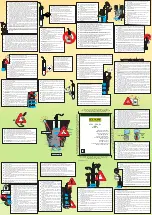
Glow T150 & T180
Tankless Condensing Water Heater
25
All units installed with vertical exhaust must
have a horizontal condensate tee piped to the
drain and must be ULC S636 approved.
Failure to properly connect the condensate
drain will cause combustion gases to enter the
room, possibly causing serious injury to
occupants or death.
Δ
Note:
Check with your municipality, local codes,
or local gas company to determine if disposal
of combustion condensate is permitted. In the
State of Massachusetts the condensate must be
neutralized prior to entering a drain.
Δ
Use only PVC, Vinyl or CPVC pipe for the
condensate drain line. Metal pipe is not suitable
for condensate discharge.
Δ
The condensate drain line should be a minimum
of 1/2” diameter that connects to the 3/4” supplied
hose and must be supported to prevent sagging.
Manufacturer will supply a 3/4” to 1/2” reducer for
connection.
Δ
Keep the length of the condensate drain as short
as possible. Long runs or applications where
the nearest drain is above the water heater will
require the use of a condensate pump. Size
the pump to allow for a maximum condensate
discharge of 2 gpm from the water heater. The
end drain pipe must not be submerged in water or
blocked in any way.
Δ Ensure the condensate is flowing freely from the
drain pipe after the system has been installed.
Condensate will begin flowing out of the water
heater within 2 minutes after operation has
started.
Δ
Do not run condensate lines outside and take
measures to prevent the condensate drain lines
from freezing (insulation, heat tape, electric
heaters, etc.).
Δ
Be sure to clean the condensate trap at least
once per year to prevent any problems, and
after cleaning be sure to check for any leaks of
condensed water or flue gas. (see Section 4.4)
3.4.6 Space Heating
Δ
Suitable for combination water (Potable) heating
and space heating (maximum set point of
63
°
C/145
°
F) and not suitable for space heating
application only.
Δ
Piping and components connected to the water
heater for the space heating application shall be
suitable for use with potable water.
Δ
Toxic chemicals, such as used for water heater
treatment, shall not be introduced into the potable
water.
Δ
A water heater which will be used to supply
potable water shall not be connected to any
heating system of component(s) previously used
with non-potable water heating appliance.
Δ When the system requires water for the space
heating at temperatures higher than required for
other uses, a means such as a mixing valve shall
be installed to temper the water for those uses in
order to reduce scald hazard potential.
Δ
The water heater can be used for potable hot
water heating and space heating (maximum
set point of 63
°
C/145
°
F) applications. Note:
the illustrations in section 3.4.7 are conceptual
designs only. There are many design variations
of the equipment presented. Designers must
add all necessary safety and auxiliary equipment
to conform to Code requirement and proper
design practice. For more details, contact the
manufacturer or distributor.
3.4.7 Thermal Shock in Combined Systems
Δ
Plumbing system design coupled with changing
system pressure can lead to thermal shock.
Thermal shock can affect the water heater’s
flow sensor and proper operation of the anti-
scald valve. To avoid this situation, we suggest
hydraulically separating the heating return line
from the cold water make up and cold port of the
anti-scald valve with the use of a check valve
(Figures 3.8, 3.9, 3.10).
Δ
Further protection can be provided with the use of
a commercially available Water Hammer Arrester
or field fabricated Thermal Shock Dampener as
shown in Figure 3.11.
Summary of Contents for T-150
Page 7: ...Glow T150 T180 Tankless Condensing Water Heater 7...
Page 8: ...Glow T150 T180 Tankless Condensing Water Heater 8...
Page 9: ...Glow T150 T180 Tankless Condensing Water Heater 9...
Page 78: ......
Page 82: ......
Page 84: ......
Page 86: ......
Page 87: ......
















































